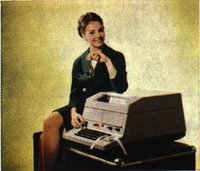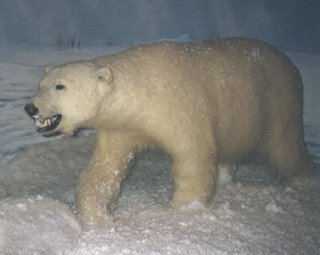Ta Dah ! ... Answers at last - Part 1
Ages ago I asked how I could have done some things in my life, and invited inventive answers. Thank you Blogging Mone and Charles for your stupendous efforts !
Since setting the quiz, Blogger has been a nuisance in not always letting me add the pictures as I composed the answers, so this has taken days and days. Here at last are the answers, posted in episodes to thwart Blogger. This is part 1 of 4. Please scroll down to the rest of the episodes.
Question 1 ~ I stroked a Polar Bear
(www.taxidermyplus.com) This picture is not the same stuffed Polar Bear that I stroked when I was small.
How 'my' Polar Bear got to Sheffield City Museum via the taxidermist, I do not know.
It was very big and not all white but tinged with yellow. Its mouth was closed, so it had probably lost all its teeth. It felt sad.
So I stroked it. My aunt lived close to the Museum, so I visited it, and stroked it, whenever I could, because no-one else seemed to.
Question 2 ~ I tobogganed clouds
A sleigh is not a sledge and a sledge is not a toboggan. This is a sledge:
In descending order of comfort, a sleigh is sprung and high off the ground, cushioned from bumps and generally pulled along on flat ground by horses (or Rudolph). A sledge is what I progressed to, from the highly unsatisfactory, not to say dangerous, tin tea tray. I was only small, the tin tea tray was smaller. That was the hard winter of 1960. A sledge is designed for whooshing down snowy slopes, avoiding humps and bumps were possible, which results in spillage of passengers.
A toboggan is flat on the ground, bumps and all, which is why a Microlight Aircraft is said to be tobogganing clouds.
Many years ago I was offered a ride in a microlight aircraft by its owner who was an RAF test pilot. How could I refuse the ride of a lifetime. The seat was small; the pilot owner instructed me "don't touch that, that's the fuel cut off; don't touch that, you'll detach the wings; if you want to hold onto anything, hold onto me" !
A summer evening, low cloud, still air. Using the turbulence caused by the clouds for lift; swooping up, just as a toboggan would go bouncing over bumps and hummocks hiding under the snow.
Although I had experienced turbulence in airplanes, I did not know
that those white fluffy clouds have a density (pressure?) that cannot
be got through by microlights, where the pilot and passenger are
sat in open seats breathing the same air as the birds.
So in order to go up through low cloud the pilot had to find a hole in the clouds and once above the cloud base, the pilot had no idea where we were. To come back down, after tobogganing the clouds, we had to find a hole in the clouds to go back through, then visually get our bearings; by peering down to the ground ! Coming down was a whole lifetime of fear worse than going up. Going up, you are looking up and it is beautiful. Coming down, you are looking down and it is not good. In the top picture I am sat behind the pilot, in helmet and goggles. In the bottom picture, in the centre, I am describing how I had left my stomach behind in the clouds.
This picture, taken while I was at College, is irrelevant, but was scanned to my laptop together with the next picture, which is relevant, and is inseperable until I can find the originals and do them seperately.
If nothing else, it proves I was once young. I am so much changed, being older, that it cannot possible identify me now.
Back to ... Question 3 ~ I drilled for oil.
Drilling for oil, well not quite, but operating the working scale model of the newly invented automatic drill bit replacement mechanism at the Offshore Oil International Exhibition at Olympia in London, in the early 1970s. Before this invention, digits, limbs and lives were lost in oil exploration. This bit of kit is common-place now.
 Another bit of kit from this era was the telex machine. This picture from www.samhallas.co.uk, not from my album.
Another bit of kit from this era was the telex machine. This picture from www.samhallas.co.uk, not from my album.
I had a varied job as PA to the Directors of a firm of Oil Contract
Consortium Leaders, in swish offices across the road from Westminster Abbey and one aspect of my work was to operate the Telex machine. From the 1930s to 1970s, in the days before fax machines and the internet, telex was the only alternative to slow letters or expensive international phone calls. Telex machines had a mechanical keyboard to record on paper tape communications sent by telegraphy at about 60 words per minute. Real time two way conversations took place via the receiving telex operator. I took dictation at the keyboard, and typed questions and answers between my Directors, or their Saudi, Iranian or Geordie colleagues, to partner organisations all over the world.
Since setting the quiz, Blogger has been a nuisance in not always letting me add the pictures as I composed the answers, so this has taken days and days. Here at last are the answers, posted in episodes to thwart Blogger. This is part 1 of 4. Please scroll down to the rest of the episodes.
Question 1 ~ I stroked a Polar Bear
(www.taxidermyplus.com) This picture is not the same stuffed Polar Bear that I stroked when I was small.
How 'my' Polar Bear got to Sheffield City Museum via the taxidermist, I do not know.
It was very big and not all white but tinged with yellow. Its mouth was closed, so it had probably lost all its teeth. It felt sad.
So I stroked it. My aunt lived close to the Museum, so I visited it, and stroked it, whenever I could, because no-one else seemed to.
Question 2 ~ I tobogganed clouds

A sleigh is not a sledge and a sledge is not a toboggan. This is a sledge:
In descending order of comfort, a sleigh is sprung and high off the ground, cushioned from bumps and generally pulled along on flat ground by horses (or Rudolph). A sledge is what I progressed to, from the highly unsatisfactory, not to say dangerous, tin tea tray. I was only small, the tin tea tray was smaller. That was the hard winter of 1960. A sledge is designed for whooshing down snowy slopes, avoiding humps and bumps were possible, which results in spillage of passengers.

A toboggan is flat on the ground, bumps and all, which is why a Microlight Aircraft is said to be tobogganing clouds.
Many years ago I was offered a ride in a microlight aircraft by its owner who was an RAF test pilot. How could I refuse the ride of a lifetime. The seat was small; the pilot owner instructed me "don't touch that, that's the fuel cut off; don't touch that, you'll detach the wings; if you want to hold onto anything, hold onto me" !
A summer evening, low cloud, still air. Using the turbulence caused by the clouds for lift; swooping up, just as a toboggan would go bouncing over bumps and hummocks hiding under the snow.
Although I had experienced turbulence in airplanes, I did not know
that those white fluffy clouds have a density (pressure?) that cannot
be got through by microlights, where the pilot and passenger are
sat in open seats breathing the same air as the birds.
So in order to go up through low cloud the pilot had to find a hole in the clouds and once above the cloud base, the pilot had no idea where we were. To come back down, after tobogganing the clouds, we had to find a hole in the clouds to go back through, then visually get our bearings; by peering down to the ground ! Coming down was a whole lifetime of fear worse than going up. Going up, you are looking up and it is beautiful. Coming down, you are looking down and it is not good. In the top picture I am sat behind the pilot, in helmet and goggles. In the bottom picture, in the centre, I am describing how I had left my stomach behind in the clouds.
This picture, taken while I was at College, is irrelevant, but was scanned to my laptop together with the next picture, which is relevant, and is inseperable until I can find the originals and do them seperately.
If nothing else, it proves I was once young. I am so much changed, being older, that it cannot possible identify me now.
Back to ... Question 3 ~ I drilled for oil.
Drilling for oil, well not quite, but operating the working scale model of the newly invented automatic drill bit replacement mechanism at the Offshore Oil International Exhibition at Olympia in London, in the early 1970s. Before this invention, digits, limbs and lives were lost in oil exploration. This bit of kit is common-place now.
 Another bit of kit from this era was the telex machine. This picture from www.samhallas.co.uk, not from my album.
Another bit of kit from this era was the telex machine. This picture from www.samhallas.co.uk, not from my album.I had a varied job as PA to the Directors of a firm of Oil Contract
Consortium Leaders, in swish offices across the road from Westminster Abbey and one aspect of my work was to operate the Telex machine. From the 1930s to 1970s, in the days before fax machines and the internet, telex was the only alternative to slow letters or expensive international phone calls. Telex machines had a mechanical keyboard to record on paper tape communications sent by telegraphy at about 60 words per minute. Real time two way conversations took place via the receiving telex operator. I took dictation at the keyboard, and typed questions and answers between my Directors, or their Saudi, Iranian or Geordie colleagues, to partner organisations all over the world.




2 Comments:
Thanks for posting all of these answers, you adventurous spirit, you!
That polar bear is so sad. I'd have been visiting him often, too.
I very much enjoyed reading about your flight in the clouds, because I would never have done that! Going up sounds just amazing, but trying to find a hole to come down through-gasp! It made me think of a seal searching for an air hole in the ice.
What a great series!
Thank you S.E.
I am thankful to have done it all; it enables me to accept with a bit of good grace, where I am now.
Post a Comment
Thank you for leaving a comment ... all comments are moderated and will be published soon.
<< Home